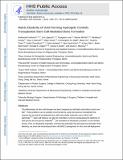| dc.contributor.author | Lippens, Evi | |
| dc.contributor.author | Lee, Kangwon | |
| dc.contributor.author | Mehta, Manav | |
| dc.contributor.author | Koshy, Sandeep T. | |
| dc.contributor.author | Darnell, Max C. | |
| dc.contributor.author | Desai, Rajiv M. | |
| dc.contributor.author | Madl, Christopher M. | |
| dc.contributor.author | Xu, Maria | |
| dc.contributor.author | Zhao, Xuanhe | |
| dc.contributor.author | Chaudhuri, Ovijit | |
| dc.contributor.author | Verbeke, Catia | |
| dc.contributor.author | Kim, Woo Seob | |
| dc.contributor.author | Alim, Karen | |
| dc.contributor.author | Mammoto, Akiko | |
| dc.contributor.author | Ingber, Donald E. | |
| dc.contributor.author | Duda, Georg N. | |
| dc.contributor.author | Mooney, David J. | |
| dc.contributor.author | Huebsch, Nathaniel David | |
| dc.date.accessioned | 2017-04-14T14:46:28Z | |
| dc.date.available | 2017-04-14T14:46:28Z | |
| dc.date.issued | 2015-09 | |
| dc.date.submitted | 2013-10 | |
| dc.identifier.issn | 1476-1122 | |
| dc.identifier.issn | 1476-4660 | |
| dc.identifier.uri | http://hdl.handle.net/1721.1/108166 | |
| dc.description.abstract | The effectiveness of stem cell therapies has been hampered by cell death and limited control over fate. These problems can be partially circumvented by using macroporous biomaterials that improve the survival of transplanted stem cells and provide molecular cues to direct cell phenotype. Stem cell behaviour can also be controlled in vitro by manipulating the elasticity of both porous and non-porous materials, yet translation to therapeutic processes in vivo remains elusive. Here, by developing injectable, void-forming hydrogels that decouple pore formation from elasticity, we show that mesenchymal stem cell (MSC) osteogenesis in vitro, and cell deployment in vitro and in vivo, can be controlled by modifying, respectively, the hydrogel’s elastic modulus or its chemistry. When the hydrogels were used to transplant MSCs, the hydrogel’s elasticity regulated bone regeneration, with optimal bone formation at 60 kPa. Our findings show that biophysical cues can be harnessed to direct therapeutic stem cell behaviours in situ. | en_US |
| dc.language.iso | en_US | |
| dc.publisher | Nature Publishing Group | en_US |
| dc.relation.isversionof | http://dx.doi.org/10.1038/nmat4407 | en_US |
| dc.rights | Article is made available in accordance with the publisher's policy and may be subject to US copyright law. Please refer to the publisher's site for terms of use. | en_US |
| dc.source | PMC | en_US |
| dc.title | Matrix elasticity of void-forming hydrogels controls transplanted-stem-cell-mediated bone formation | en_US |
| dc.type | Article | en_US |
| dc.identifier.citation | Huebsch, Nathaniel; Lippens, Evi; Lee, Kangwon; Mehta, Manav; Koshy, Sandeep T.; Darnell, Max C.; Desai, Rajiv M. et al. “Matrix Elasticity of Void-Forming Hydrogels Controls Transplanted-Stem-Cell-Mediated Bone Formation.” Nature Materials 14, no. 12 (September 14, 2015): 1269–1277. © 2015 Macmillan Publishers Limited, part of Springer Nature | en_US |
| dc.contributor.department | Massachusetts Institute of Technology. Institute for Medical Engineering & Science | en_US |
| dc.contributor.mitauthor | Huebsch, Nathaniel David | |
| dc.relation.journal | Nature Materials | en_US |
| dc.eprint.version | Author's final manuscript | en_US |
| dc.type.uri | http://purl.org/eprint/type/JournalArticle | en_US |
| eprint.status | http://purl.org/eprint/status/PeerReviewed | en_US |
| dspace.orderedauthors | Huebsch, Nathaniel; Lippens, Evi; Lee, Kangwon; Mehta, Manav; Koshy, Sandeep T.; Darnell, Max C.; Desai, Rajiv M.; Madl, Christopher M.; Xu, Maria; Zhao, Xuanhe; Chaudhuri, Ovijit; Verbeke, Catia; Kim, Woo Seob; Alim, Karen; Mammoto, Akiko; Ingber, Donald E.; Duda, Georg N.; Mooney, David J. | en_US |
| dspace.embargo.terms | N | en_US |
| mit.license | PUBLISHER_POLICY | en_US |
| mit.metadata.status | Complete | |
